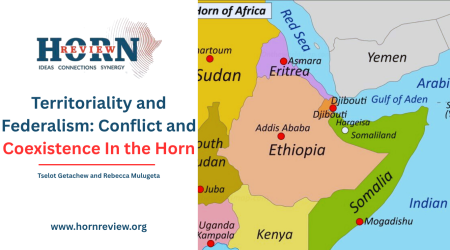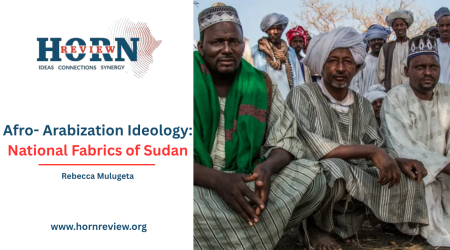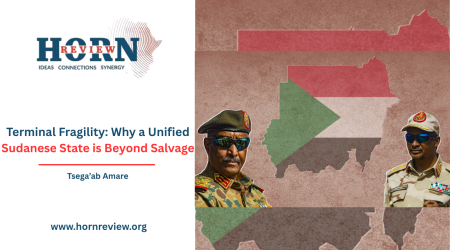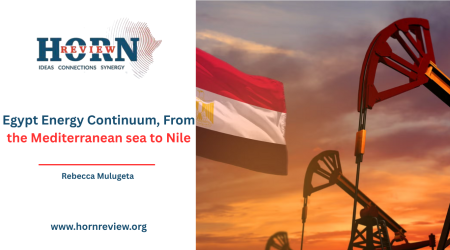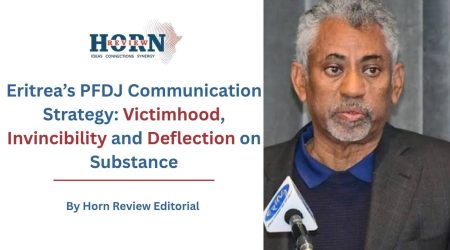
20
Nov
Eritrea’s Totalitarian Order and the “Isaias Doctrine”: A Strategic Case for its Collapse
The Horn of Africa holds a decisive geostrategic position in global politics, serving as an axis where the rivalries of established and emerging global powers intersect. Its proximity to the Red Sea, the Babel-Mandeb Strait, the Suez Canal, the Mediterranean Sea, and the Indo-Pacific maritime corridor endows the region with unparalleled geopolitical significance. For decades, these strategic realities have shaped patterns of geopolitical rivalry, military presence, trade flows, and cross-regional migration.
Among the states in this volatile region, Eritrea stands out as one that has weaponised its geography in an exceptionally destructive manner. Over the years, Isaias has entrenched a uniquely totalitarian system defined by an all-pervasive machinery of control; indefinite national conscription, a political ideology sustained through coercion, extreme isolationism, and the dismantling of social and political institutions.What has emerged is a cult personality that leaves no room for the development of functioning state institutions. His rule has hollowed out Eritrea’s statehood, eliminating any form of democratic space.
Eritrea’s internal repression has not remained confined within its borders. The regime’s militarised posture, covert interference in neighbouring states, repeated armed confrontations, and consistent obstruction of regional initiatives have all contributed to instability across the Horn of Africa. The Eritrean state under Isaias’ rule epitomises a microcosm of the historic design in which totalitarian regimes inflict domestic suffering while generating external instability, as portrayed in the case of Nazi Germany, Stalin’s Soviet Union, Idi Amin’s Uganda, and Saddam Hussein’s Iraq.
To understand Eritrea under Isais Afwerki requires a grounding in the theoretical framework of totalitarianism. Totalitarian systems are political orders in which all aspects of life, such as political, social, economic, and cultural affairs, are controlled by an omnipresent state and a single ruling elite. They rely on fear, coercion, ideological indoctrination, centralised economic control, and the fabrication of perpetual enemies, echoing the dystopian world depicted in Orwell’s seminal piece (Orwell, 1984). Classic theorists such as Friedrich & Brzezinski (1965) vividly identify core features of totalitarianism as a single ideology, a dictator elevated through a personal cult, pervasive surveillance, monopoly over media, and absolute economic domination. Arendt (1979) further notes that totalitarianism depends on the elevation of the leader to an indispensable role, making the system’s continuation inseparable from the individual’s survival. Totalitarian power thus operates not merely through repression but by a constructed worldview of unending hostility requiring total mobilisation of society.
Eritrea’s Totalitarian Playbook and the Isaias Doctrine
It is through the preceding theoretical lens that Eritrea’s political orientation, often described by scholars as the “Isaias Doctrine”, becomes intelligible. Guided by this doctrine, the People’s Front for Democracy and Justice (PFDJ) and Isaias Afwerki steered the Eritrean state away from international norms almost immediately after independence. The doctrine functions both as a political ideology and a strategic blueprint, constructing Eritrea’s state identity, political legitimacy, and nation-building project upon the sustained fragmentation and weakening of regional actors, more specifically, Ethiopia.
This orientation has been clearly articulated in a recent policy statement on Ethio-Eritrea’s Relations delivered by Minister of Foreign Affairs of the FDRE, H.E. Dr, Gedion Timothewos, at the Foreign Policy Forum convened by Horn Review and Addis Ababa University at Ras Mekonnen Hall on November 13th 2025. The Minister, in his statement, said “this Doctrine assumes that Eritrea’s continued statehood as a sovereign country is contingent upon Ethiopia’s insecurity, fragmentation, and instability. It is a doctrine that predicates Eritrea’s security on Ethiopia’s insecurity.”Scholars and international observers echo this narrative, repeatedly noting that “…the Eritrean ruling elite perceive their survival as contingent not on regional peace but on Ethiopia’s perpetual instability (ICG, 2020).” This doctrine rests on three interlinked core pillars.
- Eritrea’s survival depends on Ethiopia’s permanent weakness: Isaias and his inner circle view a strong, stable, and unified Ethiopia as an existential threat to the long-term continuity of the PFDJ. As documented by the UN Monitoring Group (UNSC, 2011), Eritrea’s strategic posture has relied on weakening Ethiopia through proxy warfare, support for armed groups, exploitation of internal political cleavages, and obstruction of peace and state-building processes.
- Eritrean nationalism must be defined in perpetual opposition to Ethiopia: The regime constructs its political consciousness by cultivating perpetual hostility and opposition toward Ethiopia (Reid, 2011). This adversarial nationalism is propagated through state-media, militarised education, ideological indoctrination, and the portrayal of Eritrea as a besieged fortress. The antagonism toward Ethiopia thus becomes a unifying political myth that sustains the internal legitimacy of the regime.
- Regional destabilisation is operationalised as an instrument of statecraft: The regime operationalises this doctrine through arming insurgent groups, supporting dissident factions in Ethiopia, infiltrating regional political landscapes, and manipulating territorial and ethnic tensions. This aligns with longstanding findings that Eritrea uses cross-border destabilisation as an integral component of its foreign policy strategy (ICG, 2020).
Through these playbooks, Eritrea seeks to trap Ethiopia in cycles of conflict and institutional fragility, thereby preventing the emergence of a cohesive and stable neighbour capable of projecting influence in the Red Sea basin and the wider Horn of Africa. In doing so, Eritrea positions itself not as a cooperative regional actor but as a strategic spoiler, maintaining leverage through the cultivation of insecurity rather than through engagement, integration, or peaceful coexistence.
Ethiopia’s Peace Anchored Policy vs. Eritrea’s Spoiler Strategy: The Imperative for Its Demise
Contrary to Eritrea’s hostile posture, Ethiopia, as the region’s anchor state, has historically pursued foreign policies grounded in peace, regional integration, and security cooperation. The 2018 rapprochement with Eritrea, embodied in the Addis Ababa and Jeddah Agreements, marked a significant diplomatic milestone aimed at ending the decades-long no-war-no-peace hostility that followed the fratricidal war. Ethiopia extended genuine goodwill by normalising relations and promoting dialogue. Eritrea, however, did not reciprocate.
Instead, the Isaias regime exploited Ethiopia’s internal conflicts, particularly during the Northern conflicts, to advance its doctrine of managed instability. Eritrea’s military involvement in Tigray resulted in grave human rights violations and atrocities, as extensively documented in the 2021 Joint Report of the UN Office of the High Commissioner for Human Rights and the Ethiopian Human Rights Commission (OHCHR–EHRC Joint Report, 2021).
Following the Pretoria Agreement, which sought to restore peace, re-establish governance structures, resume basic services, allocate regional budgets, and initiate DDR programs, Eritrea adopted a hostile posture. Viewing the agreement as a threat to its influence, the Isaias regime reverted to its familiar pattern of destabilisation, supporting defunct and dissident TPLF factions as well as armed groups such as the Fano militia, Shene/OLA, and the exiled ONLF, often in coordination with external actors. In an even more paradoxical turn, Eritrea cultivated covert tactical alliances with some of the very factions it fought during the Tigray conflict, most notably hardline elements within the TPLF war-hawk group, under an informal arrangement known as “Tsemedo (ፅምዶ).” These alliances are neither ideological nor principled; they are opportunistic instruments aimed at manipulating aspects of Ethiopia’s internal crises in pursuit of Eritrea’s long-standing destabilisation agenda.
However, this destabilisation strategy of the Eritrean government is not limited to Ethiopia. International reports have repeatedly pointed out Eritrea’s support for terrorist organisations, including Al-Shabaab, Al-Qaida, and ISIS affiliates, all of which are identified as existential threats to regional security (UN Security Council, 2011). As a result, Eritrea functions as a quintessential “regional spoiler state,” employing militant strategies and asymmetric warfare to weaken neighbouring states and expand its influence.
Scholars widely affirm this destabilising posture of Eritrea. Salih O. Nur (2013), in his analysis of Eritrea’s foreign policy, identifies a systematic pattern of conflict, confrontation, and militarised diplomacy that has produced adversarial relations with virtually all of Eritrea’s neighbours. Historically speaking, Eritrea has fought a full-scale war with Ethiopia (1998-2000), border clashes with Djibouti in the late 1990s and again in 2008, stalemate with Sudan since 1993 at different times, and waged armed conflict with Yemen over the Hanish Islands (Clapham, 2017; Reid, 2019). This recurrent belligerence exemplifies what Tronvoll (2015) characterises as a “doctrine of totalitarianism,” in which external conflict is deliberately cultivated as a tool of regime survival.
Domestically, Eritrea remains one of the world’s most repressive states. The society is militarised; media freedom is non-existent, and human rights abuses are systematic. Indefinite national conscription conducted in military camps such as Sawa Gergera, Hashenkit, Gahtelay, Kiloma, May Seraw, May Dima, Himberti, Nakfa, Wia, and Afabet combined with widespread torture and severe restrictions on civil liberties, defines Eritrea’s political order. Although a constitution was drafted in 1997, its implementation has been indefinitely suspended under the pretext that it “threatens state survival”.
Formal state institutions are largely hollow. Isaias has no vice president; the Council of Ministers is ceremonial, and all decision-making is concentrated entirely in the presidency. A small circle of hardline elites operates a shadow governance structure insulated from accountability, including Osman Saleh (Minister of Foreign Affairs); Yemane Gebreab (Presidential Advisor and PFDJ Head of Political Affairs); Yemane Gebremesekel (Minister of Information and Chief Propogandist); Abraha Kassa (Head of National Security), General Filipos Woldeyohannes (Chief of Staff of the Eritrean Defence Forces); General Sebhat Ephrem (Military Strategist and Former Defense and Energy Minister), General Teklai Kifle (Commander of the Western Military Zone and linked to cross-border criminal networks); Colonel Simon Gebredengel (Head of Military Intelligence); and Colonel Fistum Yishak (Senior Security Officer implicated in purges and torture operations).
Diplomatically, individuals such as Ambassador Sophia Tesfamariam (Permanent Representative to the UN), Biniam Berhe (Chargé d’Affaires to Ethiopia and the AU/UNECA), Estifanos Afeworki (Ambassador to Japan), and Ambassador Beyene Russom (Ambassador to Kenya) play major roles in mitigating and sanitising the regime’s totalitarian image abroad.
Economically, the totalitarian system is reinforced through rent-seeking, illicit financial flows, and PFDJ-controlled enterprises. From clientelism aspects, the party’s political and economic apparatuses are indistinguishable. The PFDJ monopolises national wealth through opaque conglomerates such as the Red Sea Trading Corporation, led by Hagos Gebrehiwot W/Kidan (Aka Hagos Kisha), which funnels proceeds into the Hidri Trust Fund. The Eritrean National Mining Corporation (ENAMCO) operates joint ventures guaranteeing at least 50% ownership by PFDJ elites (Global Financial Integrity, 2018), functioning as both a domestic monopoly and a transnational vehicle for resource extraction, smuggling, and illicit finance.
The UN Monitoring Group has documented Eritrea’s involvement in sanctions violations, arms trafficking, and the financing of militias and armed factions across the Horn of Africa and Great Lakes region. Eritrean military and intelligence officials have also been implicated in human trafficking and smuggling networks along the Eritrea-Sudan corridor with links to Gulf and Sinai criminal groups. Through these illicit activities cloaked under the guise of state sovereignty, Eritrea consolidates patronage networks, amasses foreign currency, and exports instability beyond its borders.
Propaganda is central to this destabilisation strategy. Through regime-owned outlets including Eri-TV, Shabait, Haddas Erta, and Yemane Gebremeskel’s high-volume X/Twitter account (@hawelti) amplify narratives depicting Ethiopian leaders as foreign proxies while portraying Eritrea as a guardian of regional independence, but the reality on the ground is paradoxical with what they have been framing.
Understanding the internal logic of Eritrea’s totalitarian system is therefore essential. The Isaias’s Doctrine is more than a foreign policy posture; it is the ideological backbone of Eritrea’s authoritarian survival strategy. The regime’s domestic stability is inseparable from engineered instability abroad, particularly inside Ethiopia.
Accordingly, the demise or eventual end of Afwerki’s regime is not only a moral imperative but a strategic necessity for achieving lasting peace, regional integration, and collective security in the Horn of Africa and beyond.
As a way forward, different regional and international actors could play several important roles to demise the totalitarian orthodoxy sects from the Eritrean political terrain and to safe the region and global peace.
Ethiopiashould continue to advance peaceful, diplomatic approaches and lawful avenues to defend Eritrea’s intervention in its internal affairs and secure its maritime sovereign access to the Red Sea in durable manners, deepen regional economic integration, and uphold diplomatic restraint while preparing robust defensive measures against Eritrean meddling.
The African Unionmust adopt a clear and principled stance on Eritrea’s destabilising activities and initiate an appropriate response that prevents the misguided acts of the regime.
The United Nations Security Council should recognise Eritrea’s conduct as a direct threat to international peace and security; re-impose comprehensive sanctions, including asset freezes, travel bans, and oversight of state-owned enterprises funding destabilising activities.
The International Communitymust clearly and publicly denounce Eritrea’s destabilising role rather than engaging behind the scenes, and support coordinated diplomatic, economic, and security measures.
The Eritrean Political and Civic Actors: Opposition groups, diaspora communities, and civil society actors must articulate a coherent vision for democratic transition in Eritrea and constructive engagements with neighbouring states.
By Amanuel Tadesse, International Law & Foreign Relations Expert
References
- Arendt, H. (1979). The origins of totalitarianism (Harvest Book ed.). Harcourt Brace & Company.
- Clapham, C. (2017). The Horn of Africa: State formation and decay (2nd ed.). Oxford University Press.
- Friedrich, C. J., & Brzezinski, Z. K. (1965). Totalitarian dictatorship and autocracy. Harvard University Press.
- Global Financial Integrity. (2018). The invisible book: Financial secrets imperilling capitalism and democracy.
- International Crisis Group. (2020, October 30). Steering Ethiopia’s Tigray crisis away from conflict (Africa Report No. 289).
- Nur, S. O. (2013). Foreign policy of Eritrea: Explained in the light of the ‘democratic peace’ proposition. International Journal of Peace and Development.
- Office of the United Nations High Commissioner for Human Rights (OHCHR) & Ethiopian Human Rights Commission (EHRC). (2021, November 3). Report on the situation of human rights in the Tigray region of Ethiopia.
- Orwell, G. (1984). Nineteen Eighty-Four. Penguin Books. (Original work published 1949)
- Reid, R. (2011). Frontiers of violence in north-east Africa: Genealogies of conflict since c. 1800. Oxford University Press.
- United Nations Security Council. (2011). Letter dated 18 July 2011 from the Chairman of the Security Council Committee established pursuant to resolutions 751 (1992) and 1907 (2009) concerning Somalia and Eritrea addressed to the President of the Security Council. United Nations.


